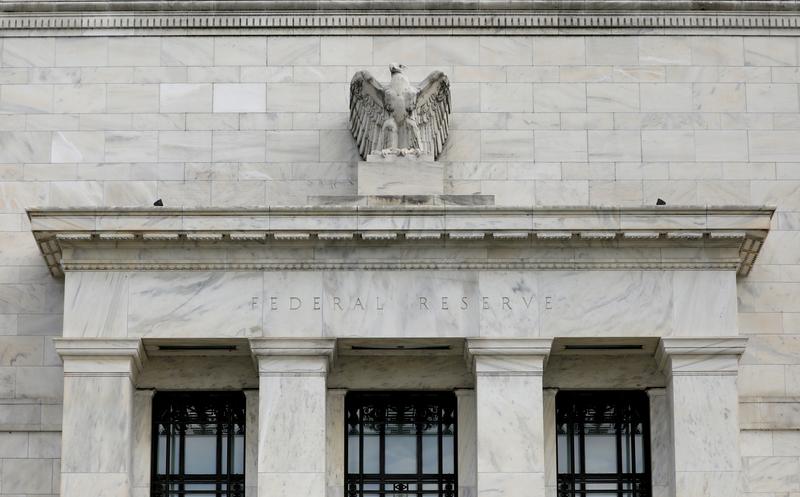(Reuters) -The U.S. economy expanded at a modest-to-moderate pace in October and the first half of November while firms grappled with rising inflation and a scramble to fill jobs amid labor shortages, a survey conducted by the Federal Reserve showed on Wednesday.
“Prices rose at a moderate to robust pace, with price hikes widespread across sectors of the economy,” the U.S. central bank said in its latest “Beige Book” report of the economy, which is compiled from anecdotal evidence derived from business contacts nationwide. “There were wide-ranging input cost increases stemming from strong demand for raw materials, logistical challenges, and labor market tightness.”
The report noted some price pressures had begun to ease, most notably for in-demand semiconductors used to make everything from electronics to motor vehicles, but the persistence of stubbornly high inflation has already forced the Fed to act to rein it in.
On Tuesday, Fed Chair Jerome Powell told the U.S. Senate Banking Committee here that the central bank will consider speeding up the end of its bond-buying program a few months earlier than anticipated on the back of a broadening of price pressures, accelerating economic growth, and strong job gains that have not been matched by an increase in labor supply. He echoed concerns about persistent inflation during a second day of testimony here in Congress on Wednesday.
The Fed began reducing its purchases of Treasuries and mortgage-backed securities, introduced to help nurse the economy through the COVID-19 pandemic, earlier this month and was set to taper the $120 billion monthly program completely by next June.
Fed policymakers will weigh a faster timeline at their next meeting on Dec. 14-15 as the central bank seeks to curb its monetary stimulus and lay the stage for a possible earlier liftoff in interest rates next year.
Investors currently see a 73% probability that the Fed will raise its benchmark overnight lending rate, currently set at the near-zero level, in June of 2022, according to CME Group’s FedWatch program.
Inflation continues to run at more than twice the Fed’s flexible target of 2% annually, and Powell acknowledged in his Senate testimony that it is not expected to ease until the second half of next year.
The Fed’s report showed that many firms were able to pass on higher prices for supplies and wages to customers with little resistance. That said, some sectors found that lifting prices was more difficult. The Chicago Fed said “numerous service firms reported holding prices steady and a few noted losing customers due to price hikes.”
INCENTIVES FOR WORKERS
Many of the Fed’s 12 districts also reported that businesses were having difficulties filling job openings at all levels, leading to a rise in salaries.
One pizzeria in Arkansas advertised pay of $15-$20 an hour for delivery drivers, the St. Louis Fed reported, and a large transportation firm, unable to fill its night shift, raised wages from $13 to $21 an hour.
Nearly all Fed districts reported robust wage growth. “Hiring struggles and elevated turnover rates led businesses to raise wages and offer other incentives, such as bonuses and more flexible working arrangements,” the report said.
The U.S. unemployment rate currently stands at 4.6% and policymakers increasingly believe that, although there are 3 million fewer people in the labor force than before the COVID-19 pandemic, not all of the shortfall will be made up due to an increase in retirements over the past two years.
Other factors holding back participation on a more temporary basis include ongoing concerns about the COVID-19 pandemic, child care, and a reduced urgency to work due to fiscal support and accumulated savings, business contacts reported.
Wage inflation shows few signs of abating, with employers in almost every industry competing to lure workers, who have been quitting at record levels. A high quits rate is seen as a sign of confidence as workers leave when they are more secure in their ability to find a new job.
The report added to recent evidence that worker scarcity was contributing to wage growth in many parts of the country. “There were widespread reports of difficulty finding and retaining workers at all skill levels, leading to a moderate increase in wages,” local business contacts told the Richmond Fed.
The New York Fed echoed that, saying that businesses in that district told of widespread ongoing difficulty in both hiring new workers and retaining existing staff, “as many employees are quitting to work for a different company or look for a new job.”
Elsewhere, the Fed said consumer spending rose modestly and that the outlook for overall activity remained positive in most districts, but some noted uncertainty about when supply-chain and labor shortages would ease.
Source: Read Full Article
